In the autumn of 2023, a venerable archimandrite of the Holy Trinity-St. Sergius Lavra, preparing for death and sorting through his old manuscripts, discovered records of the miracles of St. Nicholas and blessed them for publication. At present, many stories describing the miracles of the saint have already been published; perhaps these accounts have also been included in some collection. However, in fulfilling the blessing of the archimandrite of St. Sergius Monastery, we are publishing them on the feast day of St. Nicholas for the edification of the faithful.
 St. Nicholas of Myra. Fragment of the altar frescoes in the Dormition Cathedral of the Holy Trinity-St. Sergius Lavra.
St. Nicholas of Myra. Fragment of the altar frescoes in the Dormition Cathedral of the Holy Trinity-St. Sergius Lavra.
Keys
From the recollections of Matushka Maria Kransnotsvetova (1879–1971)
One night it was so unbearable [this was in prison] that the thought of suicide began to flicker in my completely maddened mind. Next to me lay Sister Mavstrigia. I woke her up and begged, “Marfunya, talk to me, I am completely losing strength, everything in me is dying, I’m ready to smash my head against the wall!”
Marfunya got up. She was a simple working nun, meek as a child; and she said,
“But, matushka, you are educated, and I know nothing, what can I say…”
“Marfunya, anything, just take my thoughts away from me. Tell me how you lived in the monastery, how you joined it…”
“How did I join it? They brought me from the village as an eight-year-old girl, and I stayed there forever. But you, mother, do not grieve, pray to  St. Nicholas
St. Nicholas
“>St. Nicholas the Wonderworker. He, our father, will help you. Listen to what happened to me.”
And she began her wonderful story, which then strengthened me and saved me from despair.
“Well, matushka, when we were expelled from the monastery—go wherever you want, they said—I lived with my blind sister. She was also brought from the village to me when I grew up and started working in the garden. We were heading to Tobolsk, not knowing where to go. We had nothing, just a small bundle with bread and shirts. We arrived in the city. Where to go? We came to a church. There was a service. A large icon of  Saint Nicholas: icons and frescoesPrayerful intercessor for those in need, St. Nicholas is fervently and sincerely loved by people on all continents. You will hardly find a single Orthodox church anywhere that does not have a fresco or icon with his image.
Saint Nicholas: icons and frescoesPrayerful intercessor for those in need, St. Nicholas is fervently and sincerely loved by people on all continents. You will hardly find a single Orthodox church anywhere that does not have a fresco or icon with his image.
“>St. Nicholas the Wonderworker stood there. I fell down before it, saying, ‘Father, save us! Where should we go?’ I prayed and cried. The service ended. People were leaving, but I kept standing, kept praying. A priest approached, looked at me, and said, ‘You are a nun, right?’ ‘Yes, father.’ ‘Would you like to stay with us and work, cleaning the church?’ I was so overjoyed I could hardly speak. ‘I can, father…’ ‘Well, stay then; you will have a room under the bell tower.’ ‘Father, my blind sister is with me.’ ‘Well, you will live together.’ Then the churchwarden came, showed me how to lock the church. The lock was special: it opened with a key but locked without one. I stood there as if in a dream. Did the saint of God really settle me? And so we lived with my sister under the bell tower. Glory to You, Lord! We were fed and sheltered. Every day after cleaning the church, I made three bows before the icon of the saint. We lived and rejoiced.
Once, the priest and the churchwarden came not for a service but to take lists of the faithful—this was required. The priest was very upset, and said, ‘Mavstrigia, give me the church keys quickly!’ I reached for my belt where they always hung—they weren’t there. I ran to the room: did I hang them on the wall? No. Lord, Father, where did I put them? I was terrified, ‘I don’t know, father, I can’t find the keys.’ The priest and the churchwarden were angry. ‘What kind of fool are you! Such an important matter, and you couldn’t keep the keys safe. Go look, you must have dropped them somewhere!’ I ran around the church, searching the grass, and glanced through the window where the icon of St. Nicholas was visible. I prayed to him, he would help! I looked, and there were my keys lying on the rug before the icon. When I did the three bows, they fell out, and I didn’t hear it. I locked the church without the keys and calmly went to have tea. And now this happened! I ran to the porch, and they were so angry—pity about the lock, you can’t get another like it. I shouted, ‘Father, I found the keys!’ ‘Where, where?’ ‘Here they are, look.’ And I brought them to the window. They saw the keys lying there, but how to get them? The churchwarden grumbled. ‘We don’t need workers like you! How will we get them now? We still have to break the lock.’ They both went to get some tools to break the lock. And I, in great sorrow, went back to the window to pray. I didn’t even know what I was saying, I was so scared: I was very afraid they would throw us out onto the street again. I prayed, ‘Holy Christ, pity me, my blind sister —they will throw us out again! Give me the keys, it’s not hard for you!’ I cried, ‘No, St. Nicholas the Wonderworker doesn’t hear me!’ And I went to get my sister so we could pray together. I came to the porch. Our room was in the porch under the bell tower. I looked at the church door—and the keys were hanging in the lock! I shouted and don’t remember what I cried—all I did was thank the saint. At that moment, the priest and the churchwarden entered again. ‘Why are you shouting?’ ‘Look, St. Nicholas the Wonderworker gave me the keys!’ Both the priest and the churchwarden turned pale, silently unlocked the church, and then the priest put on his epitrachelion and started a prayer service before the icon of St. Nicholas. And so I worked there until the priest was arrested and the church closed.
This is the story with which a simple, almost illiterate nun Mavstrigia comforted me. Right there, she also recited by heart the Akathist to St. Nicholas the Wonderworker, which she had vowed to read until her death. The next day, I was consoled by St. Nicholas—I received a letter from my daughter: ‘Mommy, I have arrived, don’t worry, the children are with me.’“
Saved from Rapists
In a village two kilometers from Penza, there lived a pious girl who was especially devoted to St. Nicholas. She read the Akathist to him almost daily. Some of her close ones even reproached her, saying that she was forgetting God and resorting only to St. Nicholas. The girl replied that she considered herself unworthy to address God directly, and therefore asked for help through the saint.
This girl worked as a dishwasher in one of the hospitals in Penza and every evening would walk back home to her village. She had to go through the forest, and she always tried to walk with a fellow villager. But in April 1968, one day she had to go alone. At the exit from the city to the village, there was a very narrow passage between the houses. As she walked through this passage, she saw the headlights of a truck ahead and pressed her back against one of the houses to let the vehicle pass. When the truck came alongside her, suddenly someone’s hands grabbed her by the shoulders and pulled her into the cab. A bag was immediately thrown over her head. The truck started moving. With all her might, the girl prayed to St. Nicholas for help. After some time, one man said to the other,
“Take the bag off her. What do we need her for like this?”
The bag was pulled off, but her mouth was gagged. The girl saw that the truck was heading towards the forest, but not in the direction of her village. She prayed to St. Nicholas even more fervently, more intensely than she ever had in her life. Suddenly, the truck stopped so abruptly that she slid off the seat. The cab door opened; standing before the girl was St. Nicholas himself. He extended his hand to her, led her out of the cab, calmed her, gave her water to drink, then showed her the way home and instructed her not to look back. Then the saint became invisible. The girl ran along the indicated path, and behind her, she heard desperate cries: “We’re burning, we’re burning!”
The next morning, upon arriving at work, she told her supervisor about the night’s events. Her supervisor, who was also a believer, said that two burned and paralyzed men had been brought into the city, and it was said that they had been struck by lightning. She advised the girl to go and identify them, which she did.
Then the girl went to the diocesan bishop (Bishop Theodosius (Pogorsky), 1909–1975) and told him about the miracle that had happened to her. The bishop instructed her to tell everyone about it to glorify the saint and strengthen their faith.
It seems that the girl was humble, which is why St. Nicholas appeared to her in this way. The deliverance could have been more discreet.

 Albanian Church: Legislation can’t make the unnatural natural“What is against nature cannot be made natural by legal provisions,” the Albanian Church states.
Albanian Church: Legislation can’t make the unnatural natural“What is against nature cannot be made natural by legal provisions,” the Albanian Church states.
 Macedonian Church receives tomos of autocephaly from Serbian Church“Today, by the grace of God, we have the opportunity to ratify what already exists between us, this unity that was once disturbed,” Pat. Porfirije stressed.
Macedonian Church receives tomos of autocephaly from Serbian Church“Today, by the grace of God, we have the opportunity to ratify what already exists between us, this unity that was once disturbed,” Pat. Porfirije stressed. Greek Churches can call us “Ohrid,” but we will call ourselves “Macedonian”—MOC primateDespite the joy of a previously schismatic Church of millions of people returning to the fold of the Orthodox Church, the issue of the Church’s name often takes center stage.
Greek Churches can call us “Ohrid,” but we will call ourselves “Macedonian”—MOC primateDespite the joy of a previously schismatic Church of millions of people returning to the fold of the Orthodox Church, the issue of the Church’s name often takes center stage. Macedonian bishop explains: Constantinople doesn’t recognize MOC as autocephalous because of its stance towards Ukrainian schismatics“The ‘Orthodox Church of Ukraine’ is a non-canonical church. They were ordained without grace,” Met. Timotej explained.
Macedonian bishop explains: Constantinople doesn’t recognize MOC as autocephalous because of its stance towards Ukrainian schismatics“The ‘Orthodox Church of Ukraine’ is a non-canonical church. They were ordained without grace,” Met. Timotej explained. Macedonian Church received autocephaly “without conditions, pressure, concessions, hidden interests,” says Macedonian hierarch in fiery defense of MOC-OA name and statusThe Macedonian Orthodox Church-Ohrid Archbishopric (MOC-OA) has full and complete autocephaly, and does not need to change its name in order to receive a new tomos from the Patriarchate of Constantinople, an elder bishop of the MOC-OA writes in a new statement.”>Agathangel of Povardarie, and
Macedonian Church received autocephaly “without conditions, pressure, concessions, hidden interests,” says Macedonian hierarch in fiery defense of MOC-OA name and statusThe Macedonian Orthodox Church-Ohrid Archbishopric (MOC-OA) has full and complete autocephaly, and does not need to change its name in order to receive a new tomos from the Patriarchate of Constantinople, an elder bishop of the MOC-OA writes in a new statement.”>Agathangel of Povardarie, and  Constantinople’s conditions are unacceptable for the Macedonian Church—Metropolitan of PrespaAnother hierarch of the Macedonian Orthodox Church-Ohrid Archbishopric is speaking out about the issue of his Church’s autocephaly.”>Petar of Prespa and Pelagonia.
Constantinople’s conditions are unacceptable for the Macedonian Church—Metropolitan of PrespaAnother hierarch of the Macedonian Orthodox Church-Ohrid Archbishopric is speaking out about the issue of his Church’s autocephaly.”>Petar of Prespa and Pelagonia.  Macedonian-Ohrid Church issues statement on its name and autocephalyThe hierarchs of the Synod gathered in a regular session yesterday, February 21. Among the topics discussed was the Church’s relations with other Local Churches.
Macedonian-Ohrid Church issues statement on its name and autocephalyThe hierarchs of the Synod gathered in a regular session yesterday, February 21. Among the topics discussed was the Church’s relations with other Local Churches. Russian Church officially recognizes autocephaly of Macedonian ChurchAs a sign of this recognition, the name of the MOC primate His Eminence Archbishop Stephan of Ohrid will be inscribed in the sacred diptychs.
Russian Church officially recognizes autocephaly of Macedonian ChurchAs a sign of this recognition, the name of the MOC primate His Eminence Archbishop Stephan of Ohrid will be inscribed in the sacred diptychs.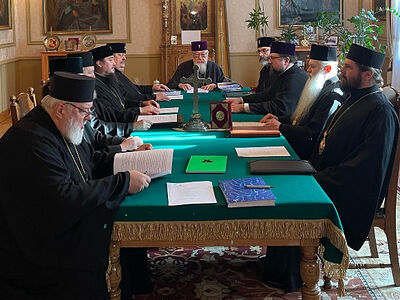 Polish Church officially recognizes Macedonian Orthodox ChurchThe Council of Bishops of the Polish Orthodox Church gathered in Warsaw on Tuesday under the chairmanship of His Beatitude Metropolitan Sawa of Warsaw and All Poland, with the participation of every bishop of the Polish Church.”>Poland,
Polish Church officially recognizes Macedonian Orthodox ChurchThe Council of Bishops of the Polish Orthodox Church gathered in Warsaw on Tuesday under the chairmanship of His Beatitude Metropolitan Sawa of Warsaw and All Poland, with the participation of every bishop of the Polish Church.”>Poland,  Primate of Macedonian Orthodox Church added to diptychs of Ukrainian Orthodox ChurchThe UOC thus recognizes the MOC as both canonical and autocephalous.”>Ukraine,
Primate of Macedonian Orthodox Church added to diptychs of Ukrainian Orthodox ChurchThe UOC thus recognizes the MOC as both canonical and autocephalous.”>Ukraine,  Bulgarian Church recognizes autocephaly of Macedonian Church, but without title “Ohrid”Another Local Church has recognized not only the canonicity of the Macedonian Orthodox Church-Ohrid Archbishopric (MOC) but also its autocephalous status, as granted it by the Serbian Orthodox Church.”>Bulgaria, and
Bulgarian Church recognizes autocephaly of Macedonian Church, but without title “Ohrid”Another Local Church has recognized not only the canonicity of the Macedonian Orthodox Church-Ohrid Archbishopric (MOC) but also its autocephalous status, as granted it by the Serbian Orthodox Church.”>Bulgaria, and  Romanian Church recognizes Macedonian-Ohrid autocephaly (updated)The autocephaly of the Macdonian CHurch is now recognized by the Churches of Russia, Poland, Ukraine, Bulgaria, and Romania, in addition to the Serbian Church.”>Romania, in addition to the Serbian Church that granted it.
Romanian Church recognizes Macedonian-Ohrid autocephaly (updated)The autocephaly of the Macdonian CHurch is now recognized by the Churches of Russia, Poland, Ukraine, Bulgaria, and Romania, in addition to the Serbian Church.”>Romania, in addition to the Serbian Church that granted it.  Constantinople enters into communion with Macedonian ChurchAccording to the new statement, Constantinople accepts the hierarchy, clergy, and laity of the MOC into communion under the name of “Ohrid,” thus “healing the wound of schism.”
Constantinople enters into communion with Macedonian ChurchAccording to the new statement, Constantinople accepts the hierarchy, clergy, and laity of the MOC into communion under the name of “Ohrid,” thus “healing the wound of schism.”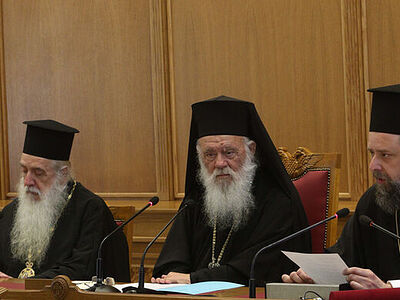 Greek Synod objects to name and territory of Macedonian Orthodox ChurchThe Permanent Holy Synod of the Church of Greece welcomes the Patriarchate of Constantinople’s decision to recognize the Macedonian Orthodox Church-Ohrid Archbishopric as canonical, but has “serious objections and reservations” about the Serbian Church’s decision to grant it autocephaly.”>Greece,
Greek Synod objects to name and territory of Macedonian Orthodox ChurchThe Permanent Holy Synod of the Church of Greece welcomes the Patriarchate of Constantinople’s decision to recognize the Macedonian Orthodox Church-Ohrid Archbishopric as canonical, but has “serious objections and reservations” about the Serbian Church’s decision to grant it autocephaly.”>Greece, 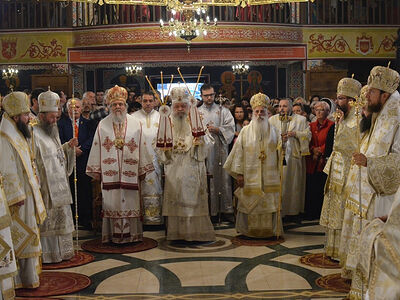 Antiochian Synod officially recognizes Macedonian Orthodox ChurchThe Antiochian Orthodox Church is the latest Local Church to officially recognize and enter into communion with the Macedonian Orthodox Church-Ohrid Archbishopric.”>Antioch,
Antiochian Synod officially recognizes Macedonian Orthodox ChurchThe Antiochian Orthodox Church is the latest Local Church to officially recognize and enter into communion with the Macedonian Orthodox Church-Ohrid Archbishopric.”>Antioch,  Georgian Church enters into communion with Macedonian ChurchThe Holy Synod of the Georgian Orthodox Church resolved to enter into communion with the Macedonian Orthodox Church-Ohrid Archbishopric at its session on Tuesday.”>Georgia, and
Georgian Church enters into communion with Macedonian ChurchThe Holy Synod of the Georgian Orthodox Church resolved to enter into communion with the Macedonian Orthodox Church-Ohrid Archbishopric at its session on Tuesday.”>Georgia, and  Albanian Church enters into communion with Macedonian-Ohrid ChurchFebruary has been a momentous month for the Macedonian Orthodox Church-Ohrid Archbishopric, as the Holy Synods of no less than four Local Churches have resolved to enter into communion with it.”>Albania recognize the Macedonian Church as canonical but not autocephalous.
Albanian Church enters into communion with Macedonian-Ohrid ChurchFebruary has been a momentous month for the Macedonian Orthodox Church-Ohrid Archbishopric, as the Holy Synods of no less than four Local Churches have resolved to enter into communion with it.”>Albania recognize the Macedonian Church as canonical but not autocephalous. 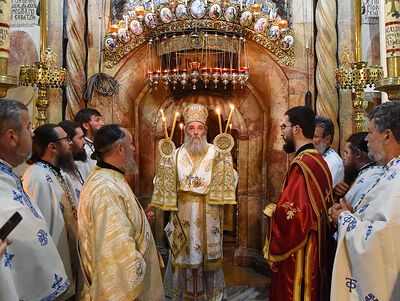 Macedonian concelebrations with Jerusalem, Romanian, Bulgarian, Russian, Serbian, Greek, Ukrainian Churches in Holy Land (+VIDEO)The Macedonian Orthodox Church-Ohrid Archbishopric continues its journey towards full acceptance in the Orthodox world after it recently received a tomos of autocephaly from the Serbian Orthodox Church.
Macedonian concelebrations with Jerusalem, Romanian, Bulgarian, Russian, Serbian, Greek, Ukrainian Churches in Holy Land (+VIDEO)The Macedonian Orthodox Church-Ohrid Archbishopric continues its journey towards full acceptance in the Orthodox world after it recently received a tomos of autocephaly from the Serbian Orthodox Church.
 St. Nicholas
St. Nicholas Saint Nicholas: icons and frescoesPrayerful intercessor for those in need, St. Nicholas is fervently and sincerely loved by people on all continents. You will hardly find a single Orthodox church anywhere that does not have a fresco or icon with his image.
Saint Nicholas: icons and frescoesPrayerful intercessor for those in need, St. Nicholas is fervently and sincerely loved by people on all continents. You will hardly find a single Orthodox church anywhere that does not have a fresco or icon with his image.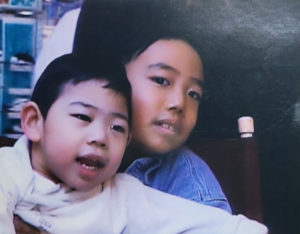
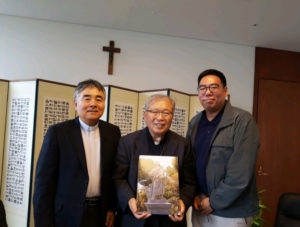
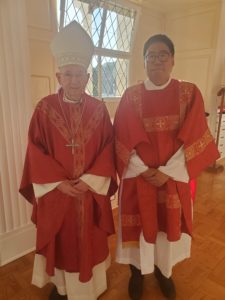


 Wonderworking Hawaiian Icon on first visit to Macedonian Orthodox church—faithful wait hours to venerate (+VIDEO)This was the first time that the icon had traveled with its guardian Fr. Nektarios Yangston to a parish of the Macedonian Orthodox Church-Ohrid Archbishopric since it was reunited to the Orthodox Church last year.
Wonderworking Hawaiian Icon on first visit to Macedonian Orthodox church—faithful wait hours to venerate (+VIDEO)This was the first time that the icon had traveled with its guardian Fr. Nektarios Yangston to a parish of the Macedonian Orthodox Church-Ohrid Archbishopric since it was reunited to the Orthodox Church last year. Paschal miracle of the wonderworking Hawaiian Iveron IconThe myrrh-streaming and wonderworking Hawaiian Iveron Icon of the Most Holy Theotokos is known throughout the Orthodox world.
Paschal miracle of the wonderworking Hawaiian Iveron IconThe myrrh-streaming and wonderworking Hawaiian Iveron Icon of the Most Holy Theotokos is known throughout the Orthodox world. The Iveron Mother of God, and the Myrrh-Streaming Icons of HawaiiIn June of 2008, the “Hawaiian” Myrrh-streaming Iveron Icon was officially recognized by the Russian Orthodox Church Outside Russia as miraculous and worthy of veneration, and was given the blessing to travel to the various churches and monasteries of Holy Orthodoxy. The original “owner” of the Icon, Reader Nectarios, was charged by the Russian Orthodox Church to be Her guardian, and provide for the safety and care of this Wonderworking Icon of Christ’s Holy Church.
The Iveron Mother of God, and the Myrrh-Streaming Icons of HawaiiIn June of 2008, the “Hawaiian” Myrrh-streaming Iveron Icon was officially recognized by the Russian Orthodox Church Outside Russia as miraculous and worthy of veneration, and was given the blessing to travel to the various churches and monasteries of Holy Orthodoxy. The original “owner” of the Icon, Reader Nectarios, was charged by the Russian Orthodox Church to be Her guardian, and provide for the safety and care of this Wonderworking Icon of Christ’s Holy Church.